1. Sicily
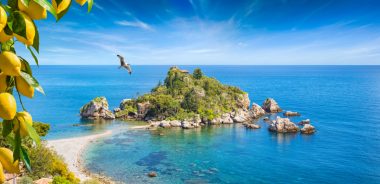
Sicily – the largest island in the Mediterranean, southwest of the tip of the Italian boot, is separated from the mainland by the 3-kilometre-wide Strait of Messina. While the north and east are characterized by cliffs and numerous bays, Sicily flattens out towards the south and offers long sandy beaches. In addition to remnants of the original forest areas, there are numerous tropical and subtropical plant species. Vegetables, fruit, wine, almonds, olives and durum wheat are grown on the island. The most famous attraction is the 3345-meter-high volcano Etna, the largest and most active volcano in Europe. The mountain areas above 2000 metres are often characterised by snow and frost in winter and can remain cool in summer, while temperatures of up to 40 degrees can be reached in the lower areas. Many migratory birds use the islands as a stopover or winter quarters.
2. Sardinia

Sardinia is located south of Corsica and can be reached via the airports of Olbia, Cagliari or Alghero. Ferry connections lead to Genoa and Civitavecchia, Tuscany and Corsica, as well as to Marseille or Barcelona, among others. The capital Cagliari with its old town is located in the far south. In addition to cliffs, the island offers many flat, fine sandy beaches and small bays. The beaches of the Costa Smeralda in the northeast and La Maddalena in the north, as well as Is Arutas in the west with different colored quartz sand are famous. Near the city of Alghero in the west, limestone cliffs fall several hundred meters deep into the sea. They are crisscrossed by numerous grottoes, such as the huge stalactite cave Grotta dei Nettuno. Sardinia is partly sparsely populated in the interior and mostly covered with mountains. The many flocks of sheep are typical. Sardinia is home to flamingos, turtles, wild horses and Sardinian deer and wild boar in the woods.
3. Cyprus

Cyprus, the third largest island in the Mediterranean, already belongs geographically to Asia. It lays 68 kilometers south of Turkey and 95 kilometers west of the Syrian coasts. The northern part of the island has been occupied by the Turks since 1974. The green line between the two parts is monitored by the UN and also divides the capital Nicosia into two halves. Cyprus can be reached via the international airports of Paphos and Larnaca. Temperatures are often determined by hot desert winds and rarely drop below 17 degrees, even in winter, while the Troodos Mountains inland have snow at this time of year. Northeast of the Troodos Mountains begins an extensive, fertile plain where fruits, vegetables, olives, almonds and wine are grown. In the interior of the island, extensive forest areas of cypresses, cedars, oaks and junipers have been preserved. Near Larnaca in the south are two large salt lakes. The island is a stopover for many migratory birds and the beaches in the north and east are used by sea turtles to lay their eggs. Throughout the ages, many peoples have left behind their heritage in Cyprus, which can be admired in museums and important archaeological sites.
4. Corsica
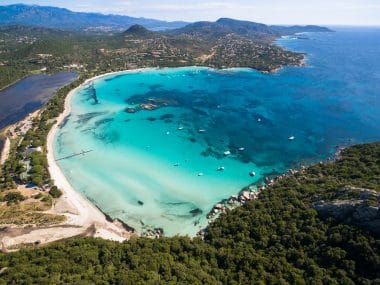
Corsica is a French island about 80 kilometers west of Italy and north of Sardinia. There are numerous ferry connections to the south of France, Sardinia and northern Italy, as well as flight connections from Ajacchio and Bastia. The west in particular is characterized by numerous bays, while the interior is dominated by a high mountain range that rises to over 2500 meters and is a paradise for hikers. Large areas are covered by sweet chestnuts and cork oaks, while in the mountains the Corsican black pine reaches a height of up to 50 metres. 40% of the island is designated as a natural park. Wild boars are widespread, but semi-wild domestic pigs also roam freely in the forests. The island is home to numerous species of birds of prey and a stopover for migratory birds. The island is not very developed for tourism, beautiful bays can be found in the southeast near Porto-Vecchio, among other places.
5. Crete
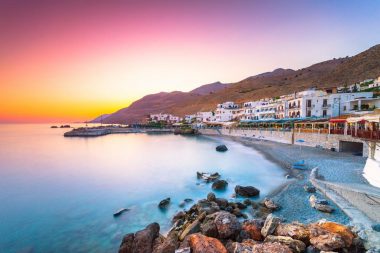
Crete, the largest Greek island, is located about 100 kilometers south of the Greek mainland and is served via the capital Heraklion or Chania in the west. From the port of Chania there is a ferry connection to Athens . From west to east stretches a mountain range up to 2500 meters high, which is interrupted by plateaus and deep gorges. The most famous is the 17-kilometre-long Samaria Gorge, which offers hikers from all over the world a challenging route with fantastic viewpoints. The north side of the island slopes shallower down to the sea, so that most of the holiday resorts can be found here. Towns such as Rethymno and Hersonissos are predominantly touristy. Agriculturally, Crete is characterized by many olive trees as well as wine and fruit growing, while numerous sheep and goats roam the area. The island of the gods is home to important archaeological sites, such as the world-famous Minoan palace of Knossos from around 2000 BC.
6. Euboea
The Greek island of Euboea reaches a length of 175 kilometers, but is only 6 kilometers wide at its narrowest point. It is dominated by a mountain range along its entire length and is connected to the mainland by two bridges over the Gulf of Euboea. The narrowest part of the strait is called Euripos and is located west of the island’s capital Chalkida. Here, only 40 meters separate the island from the mainland and Euripos is known for its unusually strong tidal changes. There are several ferry connections, including to Athens. Many sandy beaches alternate with cliffs. Tourism is not yet particularly widespread on Euboea, rather olive groves, viticulture and marble quarries characterize the island. In addition to picturesque villages, many remains from ancient times determine the image of Euboea. The town of Aedipsos in the north of the island was already known in Roman times for its numerous thermal springs and offers spa and wellness offers
7. Mallorca
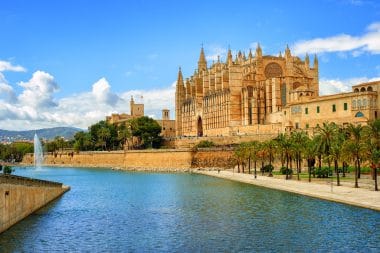
Mallorca is the largest island in the Spanish Balearic Group and is located about 170 kilometers south of the port city of Barcelona. The northwest of the island is crossed by the Tramuntana Mountains, which protect the rest of the island from cold winds and rainfall. Here the rocks drop steeply into the sea and there are only a few small bays. This area is considered a paradise for hikers and cyclists, especially in the low season. On the south side, the mountains merge into fertile valleys where olives, citrus fruits, vegetables and wine thrive. To the east is the extensive bay of Palma, where the coasts are almost completely built up and touristy. The island’s capital Palma with its famous cathedral and its old town is the cultural centre of the island. In the northeast of Mallorca, the extensive bays of Pollenca and Alcudia with their fine sand, gently sloping beaches are mainly developed for tourism, while in the southeast there are holiday resorts on numerous bays and smaller beaches. The south around Colonia de Sant Jordi is still largely undeveloped and offers several beautiful natural beaches.
8. Lesvos
The Greek island is located in the north of the Aegean Sea, about 15 kilometers from the Turkish coast. It can be reached by ferry or via the airport of the main town of Mytilene. Lesvos is characterized by steep mountain ranges, extensive pine forests and two deep bays that reach far inland from the southwest and southeast and are lined with fertile plains where mainly fruit and olives are grown. Around the island there are numerous small bays between the steeper sections of the coastlines, as well as longer beach sections at Plomari in the south and Petra in the north. In addition to the production of the well-known ouzo and the production of cheese and salt, fishing and especially tourism are other sources of income. Scattered across the island, hot thermal springs are a reminder of volcanic activity in the past. Important sights are the historic village of Molyvos with its huge castle complex and the petrified forest of Sigri with its 20-million-year-old tree trunks.
9. Rhodes
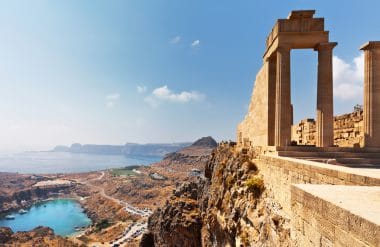
The Greek island of Rhodes is located in the southeast of the Aegean Sea, about 17 kilometers from the Turkish mainland. It can be reached via Rhodes Airport. From there there are ferry connections to other Aegean islands and towards Turkey. The island is mountainous and lined in sections with cliffs in the west and east. Herds of sheep and goats roam the island and provide the basis for the production of cheese. In addition to the cultivation of wine and olives, tourism is an important source of income. It is mainly concentrated in the north and northeast of the island. Rhodes Town was heavily fortified from the 14th century onwards by the Knights of St. John. Among other things, the Grand Master’s Palace is worth seeing. East of Rhodes, lively holiday resorts are lined up around Faliraki . The old town of Rhodes Town and the Acropolis high above the town of Lindos in the east are particularly worth seeing on the island. In the Valley of the Butterflies in the northwest there are millions of butterflies, which are magically attracted by the smell of the oriental sweetgum tree.
10. Chios

Chios is the tenth largest island in the Mediterranean Sea in the north of the Aegean Sea. The mountains in the north of the island merge into agricultural plains in the middle of the island, which are characterized by olive groves and vineyards. The south forms a plateau where the traditional natural resin mastic is extracted from pistachio trees. There are numerous fortified villages here, whose houses are decorated with geometric patterns. The ferry port in Chios Town offers numerous connections to the Aegean Sea and a ferry to nearby Cesme on the Turkish mainland. The four historic windmills near the bustling harbour promenade are the island’s landmark. The tourist center with several beaches is located a few kilometers south of Chios town. The island is characterized by numerous monasteries, of which Nea Moni with its octagonal cathedral is the most famous.




